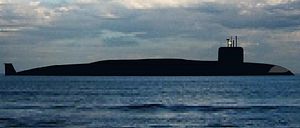We need to talk about the Indian Navy’s handling of its submarines. A report published this week in The Hindu reveals an astonishing fact: India’s sole operational indigenous nuclear-propulsion ballistic missile submarine (SSBN), INS Arihant, has suffered major damage and has been out of commission for more than nine months, during which time it has not left port. (Arihant is the lead ship of the Arihant-class of Indian SSBNs; the Indian Navy recently began outfitting the second ship of the class, INS Arighat.)
The cause of the damage, according to one source who spoke to The Hindu, was that “water rushed in because a hatch on the rear side was left open by mistake.” Human error, it seems, has done massive damage to the third leg of India’s burgeoning nuclear triad, leaving the Arihant, the result of a top secret $2.9 billion project, dead in the water for now.
For those readers who follow Indian defense affairs, the Arihant‘s fate might not seem all that surprising. The Indian Navy has not demonstrated a particularly good record in recent years in managing its conventional and nuclear-powered submarine forces.
On one hand, there are the human tragedies, like the August 2013 sinking of INS Sindhurakshak after the Kilo-class submarine suffered a major explosion while berthed in Mumbai. Eighteen sailors died in the incident, which was caused by human error, a navy investigation later found.
Less dramatic, but nearly as serious, incidents have occurred since then. In February 2014, INS Sindhuratna, an Indian Kilo-class submarine, saw a fire break out on board, leading to the death of two sailors by suffocation. While that incident was not found to have been caused by human error, it was likely due to poor maintenance and upkeep of the vessel. (India’s then-chief of naval staff, Admiral D.K. Joshi, resigned following the Sindhurakshak and Sindhuratna incidents, taking responsibility for both accidents.)
Meanwhile, more recently, India’s leased nuclear attack submarine (SSN) INS Chakra, a Russian Akula II-class, saw its sonar domes damaged late last year. Taken together with the incidents involving the two Kilo-class vessels and the Arihant now, it’s hard not to come to the conclusion that the Indian Navy’s submarine operations and maintenance could be greatly improved. Even aside from submarines, since 2010, the Indian Navy has seen a series of accidents and malfunctions across its surface warfare fleet as well.
As an aside, The Hindu‘s reporting on the Arihant‘s circumstances includes an astonishing tidbit that’s darkly illustrative of a troubling divide between the country’s political leadership and the armed forces insofar as nuclear assets are concerned. Consider this:
The absence of Arihant from operations came to the political leadership’s attention during the India-China military stand-off at Doklam. Whenever such a stand-off takes place, countries carry out precautionary advance deployment of submarine assets.
Setting aside the fascinating detail that the Doklam standoff with China in 2017 rose to the level that it merited higher SSBN readiness, it’s disturbing that India’s political leaders would learn about one leg of the country’s nuclear triad being out of commission only after they requested a precautionary advance deployment.
If this account of events is true, it raises serious questions about the extent to which the readiness of India’s nuclear forces is communicated to the political leadership. If and when unfortunate accidents do occur, the political leadership must be informed, lest it navigate diplomatic and strategic ground with faulty assumptions.
For now, the Arihant is reported to be back in harbor, undergoing repairs for damage. Even though the Indian government refuses to go on the record about its induction, there’s little doubt that this vessel — and its successors — will be the crown jewel in India’s nuclear deterrent, representing the most survivable leg of its nuclear forces. India foresees an eventual SSBN force composed of five vessels, but it’ll have to make sense of what ails its navy in maintaining and operating these submarines before another accident occurs.

































